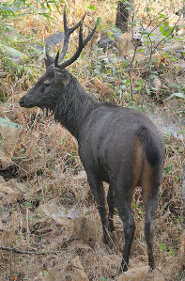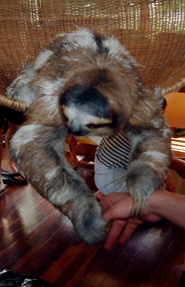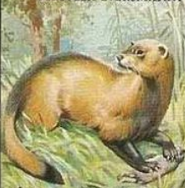Wednesday 31 December 2014
Sambar - Water-loving Deer of Southeast Asia

Sambar deer (
Cervus unicolor) are beloved by human sport hunters and by many carnivorous animals still left in the wild. Also called the sambhur deer, fully mature adults can weigh up to 1,200 pounds (546 kg), which is as much as a thoroughbred horse. They grow nearly as tall as horse, too, at 40 to 63 inches tall (102 to 160 cm.) Deer are measured like horses – from the bottom of their hooves to the highest point of their shoulders.
Originally from south and Southeast Asian countries such as India, China, Borneo, Taiwan and Myanmar, herds have been introduced to Australia, New Zealand and three American states, Texas, California and Florida. The deer were introduced solely for the convenience of sport hunters and for gourmands. In the wild, sambar deer are favored prey of lions, tigers, leopards, crocodiles, Southeast Asian wild dogs (dholes) and feral dogs.
General Description
Sambar deer are elk-like in conformation, but sport a longer tail and a shaggy dark mane that stands up when the deer is threatening intruders. They sport a dull grey-brown coat with pale bellies and underneath the tail. Bucks grow a spectacular three-pronged rack that grows about 43 inches (110 cm) long. Adult deer, both does and buck, have a strange hairless red spot mid-way down their throats. Underneath the skin of this spot is a gland that secretes musk.
Sambar deer stamp to communicate to other deer and when danger is present. When really frightened, both adults and fawns can emit high-pitched shrieks. Bucks bellow during the rut but does are quiet. Sambar stags often rub their antlers against tree trunks to mark their territory and may even rear up on their hind legs to do so.
Life and Habits
Sambar deer prefer to live near water. They are not only excellent swimmers, but water can help relieve them of parasites and serve as defense against non-human predators. Smaller predators such as
dholes cannot maneuver in water. Sambar deer have also been found 11,500 feet (3500 meters) up the Himalayan Mountains and snitching illicit snacks out of cultivated fields. Bucks live alone, except during the rut, while females and fawns live in small herds from 2 to 16 individuals.
Does have a gestation lasting seven or eight months. Normally, a single calf is born but twins occur in about 2% of sambar does. Fawns are born with light spots on a chestnut-brown coat, but these spots fade in weeks. They can walk within hours of birth and begin eating solid food at a mere 5 days old. Over the next two months, they transition from milk to an adult diet of twigs, tree bark, leaves, water plants, shrubs, herbs and fruits. Buck calves begin growing antlers when they are one year old. Unlike many other species of deer, calves stay with their mothers for up to 24 months. If lucky, a sambar deer can live nearly 20 years in the wild. The oldest sambar in captivity lived be 38. Sambar deer thrive in captivity.
Picture of the sambar by
Wikigringo, licensed under the
Creative Commons Attribution-Share Alike 2.5 Generic license.
You can help spreading the word about this animal by liking it on facebook
Permanent Link
Sunday 28 December 2014
Pale-throated Three-toed Sloth - Sloth without Ears

The pale-throated three-toed sloth (
Bradypus tridactylus) has a round but blunt head, small eyes, a slightly pointed nose but does not have visible ears, but it can hear. It lives a solitary life high up in the treetops of South American rainforests from Northern
Argentina to Southern
Honduras.
This sloth is not considered endangered, but needs Crecopia trees to survive. If the rainforest is destroyed, the chances are high that the pale-throated three-toed sloth will go extinct. Keeping it in captivity is difficult. Although slow and reliant on trees, the pale-throated three-toed sloth is far from helpless. Its three huge claws on each forepaw, which can grow up to 2.5 inches (6.35 centimeters) long, can defend itself against
jaguars and
ocelots. It is also an excellent swimmer.
Physical Appearance
Pale-throated three-toed sloths do have pale-colored throats. Their heads are shades of brown, the noses black, and their main body hair are in shades or grey, black and dark brown. However, many adults sport patches of dark green because algae grow in its shaggy fur and the sloth does not remove it. The green shades help it to blend in with the tree leaves in which it lives and feeds. Males have a bright yellow or orange splotch on their backs. Females have two prominent breasts in between their forelimbs.
Adults weigh anywhere from 4.95 to 12.1 pounds (2.25 to 5.5 kilograms). The bear-shaped long body grows to a length of 22 to 23.6 inches (56 to 60 centimeters) and sports a small, hard to see tail only 2.36 to 2.76 inches (6 to 7 centimeters) long.
Life Cycle
Pale-throated three-toed sloths breed year round. After a gestation of 141 days, the female gives birth to a single baby. The female does all of the work caring for the youngsters. She nurses the baby for one month, and then feeds the baby Crecopia leaves, twigs and buds from her own lips. She will care for the baby until it is about 9 months old, then it goes off on its own.
How slow are sloths?
It takes about one month for it to travel one mile. Sloth metabolisms are so slow that it only needs to urinate and defecate once a week. The sloth does this on the forest floor and then goes back up into the canopy. With luck, the sloth can live 12 years, although one pale-throated three-toed sloth in captivity lived to be 31.
Picture of the Pale-throated Three-toed Sloth in a rehabilitation center in Costa Rica by Connor Lee. A very young two toed sloth, in a cardboard box, is being hand fed in the righthand background. The cardboard boxes all have towels or blankets in them and are used as beds for the sloths being rehabilitated. Picture licensed under GFDL and under the
Creative Commons Attribution ShareAlike 3.0 License
You can help spreading the word about this animal by liking it on facebook
Permanent Link
Monday 22 December 2014
Steppe Polecat - Wild Relative of the Domesticated Ferret

The steppe polecat (
Mustela eversmannii), also called the masked polecat, Eversmann’s polecat or the Siberian polecat, strongly resembles a pet ferret (
Mustela putorious fero.) Although biologists think the European polecat (Mustela putorious) is the direct ancestor of the domesticated ferret because the two species can interbreed, some biologists think that the steppe polecat may also be an ancestor to the pet ferret. Unlike domesticated ferrets, steppe polecats do not come in a variety of coat colors and are hostile to people.
Steppe polecats are found from Eastern Europe to China. Although not listed as threatened or endangered, steppe polecats primarily prey on large rodents like ground squirrels, marmots, water voles and pika. If the habitat for their prey is destroyed, then the steppe polecat will lose a major food supply. Steppe polecats have been observed eating lizards, frogs, willow grouse and grey partridges. Natural predators include birds of prey,
jackals, stray dogs and foxes. Humans also prey on them, trapping steppe polecats for their fur and accidentally kill polecats trying to cross roads.
Physical Description
Steppe polecats grow larger than domesticated ferrets. They average 2 feet (60 cm) in length. Males are larger and heavier than females. One male in the wild grew to 31.5 inches (80 cm), but this is considered unusual. Males tip the scales at 72.31 ounces (2,050 grams) while females only average 47.61 ounces (1,350 grams.)
Steppe polecats possess long weasel-like bodies, short legs and a triangular head. Their bodies are chestnut-brown with a dark dorsal stripe going down the spine to the tail and black feet. Their heads, undersides of the chest and belly are white, but there are dark brown markings over the eyes which make it appear as if the steppe polecat was wearing a bandit’s mask. Their lips and sometimes the tips of their noses are pink. Their winter coat is much thicker and slightly longer than their summer coats.
Life Cycle and Behavior
Steppe polecats prefer to live in grasslands, bases of mountains and arid deserts, but can also make homes in cultivated fields and pastures. They are most active at dusk and dawn. Each steppe polecat has several burrows in its territory. It prefers to commandeer the burrows of ground squirrels rather than dig its own. Each polecat lives by itself. Females keep permanent territories while males have territories overlapping females. The sexes only get together for mating in March and April.
After a gestation of 36 to 43 days, females give birth to one to eighteen kits or baby polecats. They are born blind, deaf and hairless. They stay in their mother’s burrow for two to three months, then come up and begin to learn to hunt. They can take down an adult ground squirrel by the time they are three months old. They soon leave their mother and fend for themselves. Although they can breed sooner, the kits do not become physically mature until they are two years old. It is unknown how old steppe polecats can live in the wild.
You can help spreading the word about this animal by liking it on facebook
Permanent Link
 Sambar deer (Cervus unicolor) are beloved by human sport hunters and by many carnivorous animals still left in the wild. Also called the sambhur deer, fully mature adults can weigh up to 1,200 pounds (546 kg), which is as much as a thoroughbred horse. They grow nearly as tall as horse, too, at 40 to 63 inches tall (102 to 160 cm.) Deer are measured like horses – from the bottom of their hooves to the highest point of their shoulders.
Sambar deer (Cervus unicolor) are beloved by human sport hunters and by many carnivorous animals still left in the wild. Also called the sambhur deer, fully mature adults can weigh up to 1,200 pounds (546 kg), which is as much as a thoroughbred horse. They grow nearly as tall as horse, too, at 40 to 63 inches tall (102 to 160 cm.) Deer are measured like horses – from the bottom of their hooves to the highest point of their shoulders.
 The pale-throated three-toed sloth (Bradypus tridactylus) has a round but blunt head, small eyes, a slightly pointed nose but does not have visible ears, but it can hear. It lives a solitary life high up in the treetops of South American rainforests from Northern
The pale-throated three-toed sloth (Bradypus tridactylus) has a round but blunt head, small eyes, a slightly pointed nose but does not have visible ears, but it can hear. It lives a solitary life high up in the treetops of South American rainforests from Northern  The steppe polecat (Mustela eversmannii), also called the masked polecat, Eversmann’s polecat or the Siberian polecat, strongly resembles a pet ferret (Mustela putorious fero.) Although biologists think the European polecat (Mustela putorious) is the direct ancestor of the domesticated ferret because the two species can interbreed, some biologists think that the steppe polecat may also be an ancestor to the pet ferret. Unlike domesticated ferrets, steppe polecats do not come in a variety of coat colors and are hostile to people.
The steppe polecat (Mustela eversmannii), also called the masked polecat, Eversmann’s polecat or the Siberian polecat, strongly resembles a pet ferret (Mustela putorious fero.) Although biologists think the European polecat (Mustela putorious) is the direct ancestor of the domesticated ferret because the two species can interbreed, some biologists think that the steppe polecat may also be an ancestor to the pet ferret. Unlike domesticated ferrets, steppe polecats do not come in a variety of coat colors and are hostile to people.